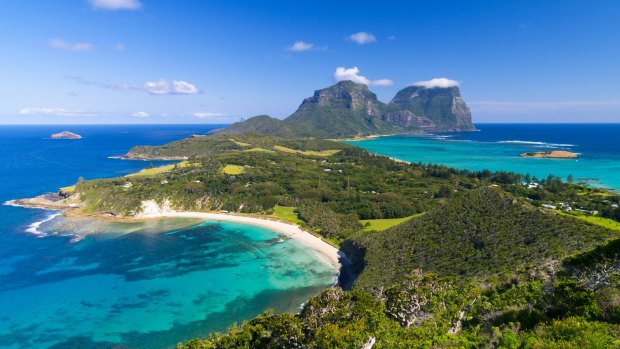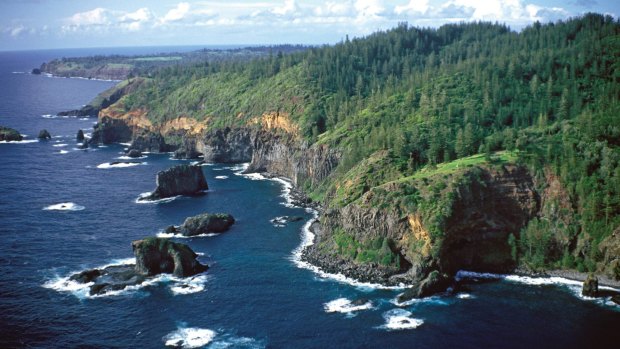This was published 7 years ago
Which island should you visit - Lord Howe or Norfolk? A guide to both
They're both small Australian islands in the South Pacific. They're both about a two-hour flight from Sydney or Brisbane. Both have subtropical climates and natural beauty. And they're both portals back to quieter, less troubled times, places where locals rarely lock their doors, you probably won't be given a room key and there are "honesty boxes" for everything from roadside produce to snorkelling gear.
It's easy to confuse Norfolk Island and Lord Howe Island. Luke Hanson, director of Pinetrees Lodge on Lord Howe, agrees. "I wish I had a dollar for every time someone asked me if we ever solved the murder," he says, referring to the tragic death of 29-year-old Janelle Patton in 2002 – on Norfolk Island.
But for all they have in common, these two little islands are very different. In fact their differences can help you decide which one to visit.

Lord Howe Island.Credit: Adobe Stock
OVERVIEW
You can't judge an island from the air, but that first glimpse does give you a preview of what it's like on the ground. From above, Norfolk Island looks like a chunk of New Zealand's bucolic North Island that has broken off and drifted north; it's roughly circular, about eight kilometres across and ringed by rugged sea cliffs. Lord Howe, on the other hand, is a supermodel to Norfolk's girl-next-door: long and slender (about 10 kilometres end-to-end and 300 metres wide at its narrowest point) with two volcanic peaks rising dramatically out of a six-kilometre-long turquoise lagoon.
LOCATION, LOCATION

Norfolk Island.Credit: Tourism Australia
Norfolk Island is more remote and slightly further north than Lord Howe: it's 1400 kilometres east of Byron Bay whereas Lord Howe is 600 kilometres due east of Port Macquarie. (The flight times are the same because Air New Zealand flies larger aircraft to Norfolk than QantasLink uses on its Lord Howe flights.) Despite the difference in latitude, Lord Howe is bathed by warm ocean currents and its summertime sea temperatures, combined with a bevy of pristine beaches and snorkelling spots, make it heaven for water-lovers. There's surf on both islands, but it tends to be fickle and is arguably more challenging on Norfolk because of its deep-water coastline.
FLY IN, FLY OUT
QantasLink flies to Lord Howe from Sydney daily and from Brisbane on weekends (there are also seasonal flights from Port Macquarie in February-June and September-December), but the flights can be expensive because they're essentially charter flights on 32-seater Dash 8s. Return flights start at $1060 if you book at least six months in advance; most visitors end up paying $1200-1300, according to Pinetrees Travel.
Flights to Norfolk Island tend to be more affordable: $600 return on average. There are only four flights a week from Australia, but the flight days make Norfolk an ideal long weekend destination: Air New Zealand flies from Sydney on Fridays and Mondays (and Sundays between October and December) and from Brisbane on Saturdays and Tuesdays. The downside is that flights depart from the international terminals, adding two hours to your travel time, and because of Norfolk Island's status as a formerly self-governing territory, you can't check in online or use the automated SmartGates at immigration. You can show photo ID at immigration, however, so won't need your passport.
FOUR WHEELS OR TWO?
Although they're roughly the same size, Norfolk feels bigger, partly because only 15 per cent of the island is national park (about 75 per cent of Lord Howe lies within its national park-like Permanent Park Preserve). It's also surprisingly hilly so the best way to get around is by car; rentals cost about $30 a day ($50 for a Moke) and some holiday deals include car rental. Just remember that the island's cows have right of way. On Lord Howe, riding a rental bike ($55 a week from Wilson's Hire) is THE way to get around on the island's quiet roads.
CROWD CONTROL
Norfolk Island also has more people. The population of Norfolk is about 1600 and it has about 1500 visitor beds, whereas Lord Howe has a permanent population of about 350 and can accommodate up to 400 visitors at a time. So it's easier to get a sense of splendid isolation on Lord Howe, but Norfolk has more tourist infrastructure (more tours and activities and a dedicated Visitor Information Centre).
The islands feel different too. Lord Howe is part of NSW while Norfolk has a unique culture with its own language, Norf'k, spoken nowhere else in the world; a fiercely independent populace (they were self-governing until July last year and still call themselves Norfolk Islanders rather than Australians); and celebrate Thanksgiving and Bounty Day (when the island's first modern-day settlers arrived from Pitcairn Island in 1856).
FOOD, GLORIOUS LOCAL FOOD
Because of strict biosecurity regulations, Norfolk imports almost no fresh produce so most of what you eat on the island was grown or made there, including coffee, goat's cheese and wine. There are more restaurants and cafes than you'd find in a regional Australian town of only 1600 people, as well as roadside stalls, a farmers markets on Saturday mornings, and foraging and foodie tours.
Lord Howe, on the other hand, grows some of its produce and gets the rest from mainland Australia (a cargo ship arrives from Port Macquarie every fortnight) so all-inclusive lodges such as Pinetrees, Arajilla or Capella tend to be more popular than self-catering holiday houses and apartments.
Both islands have an abundance of fresh, sustainably caught seafood, but no commercial fishing; charter boats supply hotels and restaurants with their catches of the day.
NATURAL WONDERS
While both islands are clean and green, and neither has any nasties found on mainland Australia such as poisonous snakes or spiders, Lord Howe Island wins on the nature stakes. The entire island was World Heritage-listed in 1982, is a model of sustainability and is surrounded by a marine park (declared in 1998). It is also remarkably unspoilt because there's no record of any pre-European settlement (Norfolk Island was inhabited by Polynesians before the first Europeans arrived). Lord Howe also has the world's most southerly coral reef, a multitude of dive sites, and is a birdwatchers' paradise: more seabirds breed on Lord Howe than anywhere else in Australia.
HISTORY TIME
Norfolk is an island built on stories. It can take time to get your head around its convoluted history, but in a nutshell: Polynesians first settled the island in 1200AD (and remained until about 1600AD), Captain James Cook first set eyes on Norfolk Island in 1774, then came two convict settlements (1788-1814 and 1825-1855) and finally the Pitcairn Islanders (descended from Bounty mutineers who outgrew their original island home and arrived on Norfolk on June 8, 1856). As a result, there are multiple ways to step back in time including four museums at Kingston, the island's World Heritage-listed convict site, ghostly dinner tours and historic plays.
DIGITAL DETOX – OR NOT
Staying on Lord Howe, you could quite easily start believing that the rest of the world has ceased to exist. Your smartphone won't work and if your accommodation doesn't offer Wi-Fi (many don't) you'll have to ride your bike to the museum or Anchorage cafe to check your emails.
On Norfolk Island it's easier to stay in touch. A basic mobile phone is often provided by accommodation hosts, so you can book tours and make dinner reservations. You can buy a Norfolk Telecom SIM card or a "hotspot" card for mobile Wi-Fi. Your hotel room will probably even have a television with regional Australian channels, and Radio Norfolk broadcasts ABC News twice a day.
THE VERDICT
Having visited both islands more than once, I'd return to either one in a heartbeat, for different reasons. Norfolk Island feels like a big friendly country town surrounded by sea. It's wild and green, dominated by farmland and forests of its eponymous pine trees, has a fascinating history and unique island culture and is ideal for history buffs, foodies, families or groups (there's plenty of self-contained accommodation) and music-lovers (for the annual jazz, country and ukulele festivals).
Lord Howe Island, on the other hand, is one of the most naturally beautiful islands in the world with its long Fiji-blue lagoon protected by the world's most southerly coral reef and two mountains that wouldn't look out of place in Tahiti. It's a barefoot kind of place, a place to get back to simple pleasures, and perfect for adventure travellers, nature-lovers, couples and young families.
TRIP NOTES
NORFOLK ISLAND
MORE
FLY
Air New Zealand flies from Sydney and Brisbane, see airnewzealand.com.au
STAY
Auwas Island Holiday Home is a three-bedroom contemporary house in a quiet location, from $200 a night. See auwasholiday.com
See also: Auwas Island Holiday Home review: Perfect base for exploring Norfolk
HIGHLIGHT
Scenic drives and eating locally with ease.
LOWLIGHT
An international flight and shops are closed on Sundays and Wednesday afternoons.
QantasLink flies from Sydney, Brisbane and Port Macquarie, see qantas.com
STAY
Pinetrees Lodge, voted Australia's best hotel on TripAdvisor this year, has all-inclusive five-night packages from $1928, see pinetrees.com.au
See also: Pinetrees Lodge review: Yoga and wellness retreat
HIGHLIGHT
The natural environment is unspoiled and accessible.
LOWLIGHT
QantasLink flights can be expensive.
FIVE THINGS TO DO ON NORFOLK ISLAND
1. Fletcher's Mutiny Cyclorama. More than a 360-degree mural, this 3D experience immerses you in the island's Bounty history. See norfolkcyclorama.com
2. Trek Phillip Island. This rugged offshore islet inhabited only by seabirds is a real adventure to get to. See trekking.nf
3. Taste Norfolk Island. The popular annual Taste Norfolk Island Food Festival is held November 27 to December 1 this year. See norfolkislandfoodfestival.com
4. Swim at Emily Bay. Norfolk's most beautiful beach is like a natural swimming pool – on the edge of a World Heritage convict site.
5. Norfolk Island National Park. Coastal walks, botanical gardens and a native bird app are just a few of this park's attractions. See parksaustralia.gov.au/norfolk
FIVE THINGS TO DO ON LORD HOWE ISLAND
1. World Heritage walks: All Lord Howe's walking tracks are spectacular, but the best and toughest is the all-day Mt Gower trek. See lordhoweislandtours.net
See also: Lord Howe's Seven Peaks Walk: Australia's newest great hike
2. Go snorkelling. Guided snorkelling trips in the island's marine park with tropical fish and Galapagos reef sharks are a must. See lordhoweislandtours.com
3. Feed the fish. Stand knee-deep in gin-clear water hand-feeding silver drummer at Ned's Beach, also ideal for swimming and beach barbecues.
4. Go birdwatching. Seabirds such as providence petrels nest here in their hundreds of thousands. See lordhoweislandtours.com
5. Sunset drinks. Seeing the sun set over the sea is a treat when you live on Australia's east coast; the best spot is the beach facing the lagoon.
Louise Southerden travelled to both islands as a guest of Norfolk Island Tourism and Pinetrees Lodge on Lord Howe Island.
See also: Dream destinations: Australia's 20 best holiday islands
See also: Aussie untouched islands home to a notorious horror
Sign up for the Traveller Deals newsletter
Get exclusive travel deals delivered straight to your inbox. Sign up now.